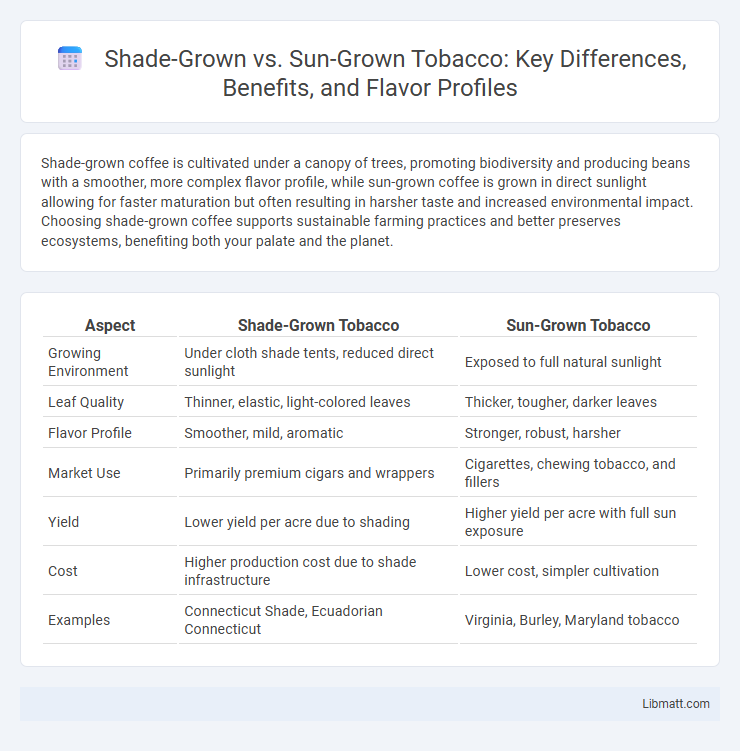Shade-grown coffee is cultivated under a canopy of trees, promoting biodiversity and producing beans with a smoother, more complex flavor profile, while sun-grown coffee is grown in direct sunlight allowing for faster maturation but often resulting in harsher taste and increased environmental impact. Choosing shade-grown coffee supports sustainable farming practices and better preserves ecosystems, benefiting both your palate and the planet.
Table of Comparison
| Aspect | Shade-Grown Tobacco | Sun-Grown Tobacco |
|---|---|---|
| Growing Environment | Under cloth shade tents, reduced direct sunlight | Exposed to full natural sunlight |
| Leaf Quality | Thinner, elastic, light-colored leaves | Thicker, tougher, darker leaves |
| Flavor Profile | Smoother, mild, aromatic | Stronger, robust, harsher |
| Market Use | Primarily premium cigars and wrappers | Cigarettes, chewing tobacco, and fillers |
| Yield | Lower yield per acre due to shading | Higher yield per acre with full sun exposure |
| Cost | Higher production cost due to shade infrastructure | Lower cost, simpler cultivation |
| Examples | Connecticut Shade, Ecuadorian Connecticut | Virginia, Burley, Maryland tobacco |
Introduction to Shade-Grown vs Sun-Grown
Shade-grown coffee is cultivated under a natural canopy of trees, preserving biodiversity and promoting sustainable ecosystems, while sun-grown coffee thrives in open, direct sunlight, often resulting in faster growth but increased environmental impact. Shade-grown methods support soil fertility and provide habitats for wildlife, contrasting with sun-grown techniques that can lead to soil degradation and higher carbon emissions. Consumer demand for environmentally friendly products is driving interest in shade-grown coffee as a more sustainable alternative.
Defining Shade-Grown and Sun-Grown Practices
Shade-grown coffee is cultivated under natural canopy layers that enhance biodiversity and protect soil health, while sun-grown coffee is grown in open fields with direct sunlight, typically yielding higher short-term productivity but increased environmental impact. Shade-grown practices promote sustainable ecosystems and contribute to slower, nutrient-rich bean development, resulting in distinct flavor profiles. Your choice between shade-grown and sun-grown coffee affects both ecological sustainability and the sensory qualities of the final product.
Historical Background of Growing Methods
Shade-grown coffee originated centuries ago in indigenous agroforestry systems of Central and South America, where native trees provided canopy cover essential for diverse ecosystems. Sun-grown coffee, developed primarily in the mid-20th century, was introduced to increase yields through full sun exposure, often resulting in faster maturation but reduced biodiversity. Your choice between these methods reflects a balance between preserving traditional ecological practices and maximizing agricultural productivity.
Environmental Impact Comparison
Shade-grown coffee supports biodiversity by preserving forest canopies, reducing habitat loss, and promoting soil health, whereas sun-grown coffee often leads to deforestation, increased carbon emissions, and soil degradation. The environmental impact of shade-grown cultivation includes lower pesticide use and better water retention, benefiting surrounding ecosystems. Choosing shade-grown coffee aligns with your commitment to sustainable agriculture and environmental conservation.
Effects on Plant Health and Yield
Shade-grown coffee plants benefit from reduced temperature stress and slower ripening processes, which enhance bean quality and maintain plant health by mimicking natural forest conditions. Sun-grown coffee typically produces higher yields due to increased photosynthesis but often suffers from greater pest vulnerability, leaf damage, and soil degradation. Balancing yield and plant health requires careful management practices that consider the microclimate differences between shade and sun cultivation systems.
Flavor and Quality Differences
Shade-grown coffee beans develop slower, resulting in denser, more flavorful beans with complex aroma profiles and balanced acidity. Sun-grown coffee matures faster, often producing beans with a more straightforward taste and higher bitterness due to increased exposure to direct sunlight. Your choice between shade-grown and sun-grown influences the final flavor intensity and overall quality of the coffee experience.
Biodiversity and Ecosystem Benefits
Shade-grown coffee supports higher biodiversity by preserving native trees and providing habitat for birds, insects, and other wildlife, which enhances ecosystem stability. Sun-grown coffee often involves clearing forests, leading to habitat loss, soil degradation, and reduced carbon sequestration. Your choice of shade-grown coffee contributes to conserving crucial ecosystems and promoting sustainable agricultural practices.
Economic Considerations for Farmers
Shade-grown coffee requires higher initial investment and labor costs due to slower plant growth and maintenance of canopy trees, but it often yields premium market prices and supports biodiversity, which can attract eco-conscious consumers. Sun-grown coffee produces higher short-term yields and faster harvest cycles, offering immediate economic benefits but risks soil degradation and increased vulnerability to pests and diseases, potentially leading to long-term financial instability. Your choice between shade-grown and sun-grown methods will impact profitability, sustainability, and market positioning based on regional climate and access to specialty coffee markets.
Consumer Preferences and Market Demand
Consumer preferences increasingly favor shade-grown coffee due to its perceived superior flavor profile, sustainable cultivation methods, and ecological benefits. Market demand reflects this trend, with specialty coffee buyers willing to pay premium prices for beans sourced from shade-grown environments that support biodiversity and soil health. Your choice to support shade-grown coffee influences the growth of sustainable agriculture and aligns with an expanding market valuing ethical and high-quality products.
Future Trends in Growing Practices
Shade-grown coffee cultivation promotes biodiversity and sustainable ecosystems, aligning with future trends in environmentally conscious agriculture. Sun-grown methods prioritize higher yield but often lead to deforestation and soil degradation, which may face increasing regulatory restrictions. Your choice between these practices can significantly impact environmental sustainability and market demand as consumer preferences shift towards eco-friendly products.
shade-grown vs sun-grown Infographic

 libmatt.com
libmatt.com